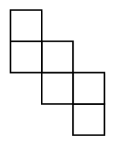Problems
It is known that it is possible to cover the plane with any cube’s net. Show how you can cover the plane with this net:

Draw a picture how Robinson could have used pegs and ropes to tie the wolf and the goat so that the goat grazed an area in the shape of a ring (like a disc with a hole in the middle).
Can two tied wolves keep an untied goat in a triangle?
Sophia is playing the following game: she chooses a whole number, and then she writes down the product of all the numbers from \(1\) up to the number she chose. For example, if she chooses \(5\), then she writes down \(1\times 2 \times 3 \times 4 \times 5\). What is the smallest number she can choose for her game, such that the result she gets in the end is divisible by \(2024\)?
While studying numbers and their properties, Robinson came across a three-digit prime number whose last digit equals the sum of the first two digits. What are the options for the last digit of this number, given that none of its digits is zero?
When Robinson Crusoe and his friend Friday learned about divisibility rules, Friday decided to proposed his own rule:
if a number is divisible by \(27\), then the sum of its digits is also divisible by \(27\).
Was Friday right?
One day Friday multiplied all the numbers from 1 to 100. The product appeared to be a pretty large number, and he added all the digits of that number to receive a new smaller number. Even then he did not think the number was small enough, and added all the digits again to receive a new number. He continued this process of adding all the digits of the newly obtained number again and again, until finally he received a one-digit number. Can you tell what number was it?
Can a \(300\)-digit number, with one hundred \(0\)s, one hundred \(1\)s, and one hundred \(2\)s among its digits, be a square number?
Robinson Crusoe’s friend Friday was looking at \(3\)-digit numbers with the same first and third digits. He soon noticed that such number is divisible by \(7\) if the sum of the second and the third digits is divisible by \(7\). Prove that he was right.
Prove the following divisibility rule by 37: divide the number starting from the right end of the number into blocks of three digits. Now, the original number is divisible by 37 if the sum of all three digit numbers obtained in this way is divisible by 37.
(It might be the case that the number of digits is not divisible by 3, and you cannot divide the original number into blocks of three digits. To overcome this problem we allow a block of three digits to start from 0, for example number 2345678 should be divided into blocks of three digits as 002, 345, and 678.)